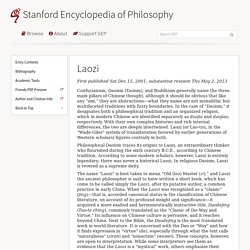

Three thoughts on the group mind. Laozi (Stanford Encyclopedia of Philosophy) 1.

The Laozi Story The Shiji (Records of the Historian) by the Han dynasty (206 B.C.E.–220 C.E.) court scribe and historian Sima Qian (ca. 145–86 B.C.E.) offers a “biography” of Laozi. Its reliability has been questioned, but it provides a point of departure for reconstructing the Laozi story. Laozi was a native of Chu, according to the Shiji, a southern state in the Zhou dynasty (see map and discussion in Loewe and Shaughnessy 1999, 594 and 597).
His surname was Li; his given name was Er, and he was also called Dan. “Laozi cultivated Dao and virtue,” as Sima Qian goes on to relate, and “his learning was devoted to self-effacement and not having fame. The World Without Forms – GODS & RADICALS. I said to a friend, we see the darkness, and some go in.

It is the Abyss. We have to find out what is there, to find out if there is meaning. And we see only the abyss. And some go mad. And some never return. A question. The power of one. The cure. Hierarchy of as-if. Jungian senoi dreamwork revisited. Crowds and power. The Hundredth Monkey Revisited. Is there some magic key that provides a short cut to cultural transformation?

Elaine Myers has had articles in issues #2, #5, and #7. She lives in rural southwest Washington state. THE STORY OF "The Hundredth Monkey" has recently become popular in our culture as a strategy for social change. Lyall Watson first told it in Lifetide (pp147- 148), but its most widely known version is the opening to the book The Hundredth Monkey, by Ken Keyes. (See below.) Structure of scientific revolutions. Verschlimmbesserung. As Confucius says (Analects 58): "If terms are incorrect, language will be incongruous; and if language be incongruous, deeds will be imperfect...

Hence, a man of superior mind, certain of his terms, is fitted to speak; and being certain of what he says can proceed upon it. " Awhile back i encountered the German term Verschlimmbesserung--an "improvement" that makes things worse (via BetterThanEnglish dot com). This seems very much of our times, when tamper monkeys not only have seized control of the means of production, they also seem infected with a restlessness entirely disconnected from any awareness of the consequence of their actions. I thought about finding an easier to remember word. Clearly, abprovement & deprovement (rather than simply mux up et al) retain the turn of wit upon the original. Tulpas & Slenderman.
Transcript for Slenderman & Tulpas Read episode notes Brooke: Great to be with you here on this Tuesday.

I’m Brooke Baldwin we have to begin with this ghost story and a character named “Slender Man” allegedly inspired two young girls, I’m talking middle school, to lead their young friend into the woods and stab her nineteen times. male speaker: New details now emerging about the possible motive behind the stabbing, according to court documents, Morgan Geyser and Anissa Weier, charged as adults with attempted first degree intentional homicide believed they would become agents for a fictional Internet character named Slender Man, by killing their friend. male speaker: According to court documents the two plotted to kill their friend to please Slender Man, a demonic fictional character on the horror site, Creepy Pasta. audio: It is most commonly known as Slender Man. female speaker: Slender Man. male speaker: Slender Man.
On Tulpas, Tulpamancers and Alexandra David-Néel. Yesterday, Chris Bell’s Facebook feed alerted me to an article by Vice, describing the phenomena of ‘tulpas’ and the ‘tulpamancers’ who create and nurture them.

For those of you who may not be familiar (as I was not), tulpas are beings created in the imagination of the tulpamaner, but which acquire their own sentience. According to Vice, tulpamancers spend some 200 to 500 hours in intense focus ‘forcing’ their tulpas to appear. Once that happens, though, tulpamancers are convinced that their creations have independent mental lives of their own. They can hold conversations with their host, dictate letters and even fall in love. The Real Meaning of Egregore. The word "Egregore" derives from the Greek word egrégoroi, meaning "watchers," which also transliterates as "Grigori.

" The word appears in the Septuagint translation of the Book of Lamentations, as well as the Book of Jubilees and the Book of Enoch. Even being derived from the word Grigori, which acquired a somewhat negative aspectation over the time, the general concept of Egregore is not evil. Gaetan Delaforge, in Gnosis Magazine in 1987, defines an Egregore as a kind of group mind which is created when people consciously come together for a common purpose. I and Thou. Reprinted with permission from The Jewish Religion: A Companion, published by Oxford University Press.

Mimesis. Erich Auerbach (1892-1957) was a German Jew trained in the German philological tradition.

Forced to flee Germany, he spent the war years in Istanbul, where he wrote his greatest work, Mimesis: The Representation of Reality in Western Literature. After the war, Auerbach came to the United States, where, from 1950 to his death, he was a professor at Yale. The Concept of Irony. Laws of Form.